Saltwater Tackle & Knots
Saltwater fishing tackle ranges from tiny shad jigs to giant shark hooks. Whether you're saltwater flats fishing with light tackle or deep-sea fishing using heavy tackle, many of the same saltwater fishing techniques apply. Learn how to use your saltwater fishing tackle and how to tie knots.
Saltwater Knots
Knots, especially those used for saltwater fishing, should always be tied with proper fishing line knots as you never know how big that next fish will be. Learn what are the best knots for saltwater fishing.
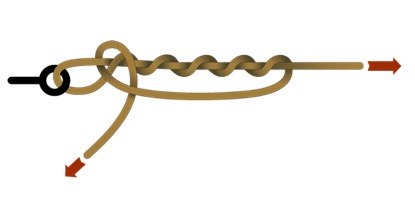
SALTWATER FISHING KNOTS
There are hundreds of saltwater fishing knots, but most anglers only need to know a handful of knots:
Improved Clinch Knot:This type of knot is best for securing your line to a lure, swivel, clip or artificial fly.
Uni knot:This type of knot is easy to tie and very strong. It’s good for connecting line to lures, snaps or swivels.
Blood knot:This knot will join two similar pieces of line, but a bimini twist or an Albright knot is best for joining fishing lines of different diameters. Learn how to tie a dropper loop, and you’ll be able to tie your own bottom rigs.
SALTWATER FISHING SWIVELS, SNAPS AND CRIMPS
Fishing swivels, snaps and crimps are the weakest links in the fishing chain. Choosing the correct connectors will strengthen the system. The best fishing swivels use ball bearings to turn freely and increase strength. The latest generation of fishing swivels is ultra small and very strong. Snap swivels are great for changing out lures or rigs without having to re-tie, but they are weaker than straight swivels. For heavy line (more than 100 pound test), metal crimps replace knots. Fishing swivels and snaps are rated by pound test or size number; be sure that the size of the connector matches or exceeds the pound test of the line.
To learn about different types of saltwater fishing rigs visit our next section.
Saltwater Fishing Line
Today’s saltwater fishing line is strong and subtle, capable of casting a long distance, transmitting the slightest tap, resisting abrasion and stopping a big fish. Learn different types of saltwater fishing line available.
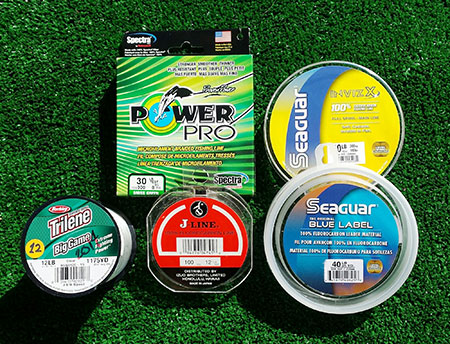
Things to consider when buying saltwater fishing line:
- Fishing line is classified by "pound-test," or the pounds of pressure it takes to break the line. The pound-test of the line you use is determined more by the amount of drag pressure you apply than it is by the size of the fish you might catch.
- Huge fish are caught on light line by anglers using little drag and a lot of patience. Lighter line will cast farther and sink faster, while heavier line is stronger and stiffer.
- Look closely at line color. High-visibility saltwater fishing line is easier to see, but camouflaged or clear line will be virtually invisible to the fish. Once you’ve settled on the pound test and color of the line, the next step is to choose monofilament, fluorocarbon or braid.
MONOFILAMENT SALTWATER FISHING LINE
Monofilament, or mono, is the most popular fishing line for most applications. Mono is thin, strong and subtle. It is also water resistant and has good knot strength. Monofilament is more abrasion-resistant than braided line, but it has greater width-to-pound test and stretches more than braid. The best mono will have a thin diameter and low memory, which means it doesn’t retain loops when it comes off the spool. Look for line with the lowest diameter-to-pound test ratio for the best performance. Monofilament will break down when exposed to direct sunlight and should be changed every six months to a year depending on how often it is used.
BRAIDED SALTWATER FISHING LINE
Unlike mono, braided lines are made by fusing several strands of fibers together. Braided lines are stronger per diameter than monofilament — you can often get 60 pounds of breaking strength in braided line that has the same diameter as 30-pound test monofilament. For this reason, braided line will cast farther and cut through the water faster than mono. Unlike mono, braided lines do not break down in the sun and salt so they last longer. Braid also has very low stretch and is very sensitive, making it perfect for bottom fishing. On the other hand, low-stretch line does not work well for trolling and requires a lighter drag setting and softer hand (less aggressive technique) when fighting fish.
FLUOROCARBON SALTWATER FISHING LINE
Fluorocarbon is a new type of fishing line. The major advantage of fluorocarbon line over mono and braid is that it has very low light refraction, making it virtually invisible underwater. Fluorocarbon is stiffer than mono and more abrasion resistant. It is also denser, meaning that it sinks faster. For the most part, fluorocarbon line is used for tying leaders to saltwater fishing lines. Fluorocarbon is stiffer than mono, making it difficult to use to tie knots. It also breaks down in sunlight, losing its strength and invisibility.
WIRE
Wire is an effective leader material when facing toothy fish. You can also use wire or lead-core line to troll a bait deep in the water. Wire comes in two varieties: braided and single strand. Single strand is thinner and stronger than braided wire, but it doesn’t bend well. Braided wire is easy to work with and bends easily enough to be tied in knots and used as main line. Situations that require you to troll at a specific depth require lead-core line.
SPOOLING FISHING LINE
Spooling saltwater fishing line is more difficult than it may seem. For the best results, take your reels to a pro shop to have them filled. For do-it-yourselfers, the key is to keep the line from twisting. To spool a saltwater spinning reel, lay the spool on the floor, run the line through the guides on the rod, and use an arbor knot to attach the line to the reel spool. Before tying braid fishing line to the spool, wrap a short piece of electrical tape around the arbor of the reel to prevent the line from slipping. Pinch the line between your fingers in front of the reel and turn the reel handle to put a dozen wraps on the spool.
To test if the saltwater fishing line is going on correctly, drop your saltwater fishing rod tip to put slack in the line. If the fishing line starts to twist and spin into loops, then it is twisting. Flip the feeder spool over and continue to fill the reel. To fill a conventional saltwater fishing reel, place a pencil through the center of the feeder spool and hold it so the line comes off the top of the spool. Always wind the fishing line under pressure and fill the reel to one-eighth of an inch below the top of the spool. Be sure to recycle your old monofilament and dispose of braided line so that it doesn’t get into the water.
SETTING THE DRAG
Drag is the amount of pressure that the reel applies to the line when a fish is pulling on it and should be set at one-third the pound-test of the line. For example, 30-pound line can handle 10 pounds of drag. To set the drag, put the rod in a holder and pull on the line with a hand scale. Tighten the drag until the scale indicates the desired amount of pressure.
Saltwater Fishing Sinkers
Fishing sinkers get the bait into the feeding zone. Whether saltwater trolling, drifting or fishing at anchor, sinkers of different sizes and shapes will put the bait at different depths in the water column.
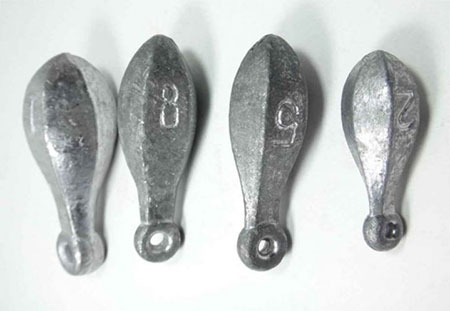
The general rule of thumb is to use the lightest sinker that will keep the bait in the feeding zone. Saltwater fishing sinkers are just as specialized as hooks and rigs. Most are made out of lead, but some anglers are experimenting with biodegradable sinkers made with pressurized iron oxide, and even clear models made from silica crystal. Regardless of size, shape or content, using the right sinker will put your bait in the feeding zone.
BANK SINKERS
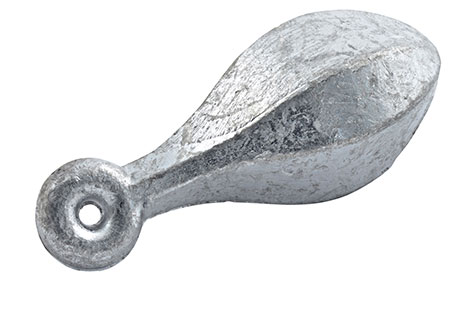
Bank sinkers are usually used to put a bait close to the bottom. Most are round or bell-shaped so they don’t get snagged in the structure. Some bank sinkers connect to the line with a swivel to reduce line twist. Others feature sharp edges and points to stick in soft sand, or have wires that stick out and hold like an anchor. Bank sinkers can either be tied to the end of the rig or attached to a fishfinder slide above the hook. The objective of a bank sinker is to stay on the bottom without getting stuck in the bottom.
EGG SINKERS
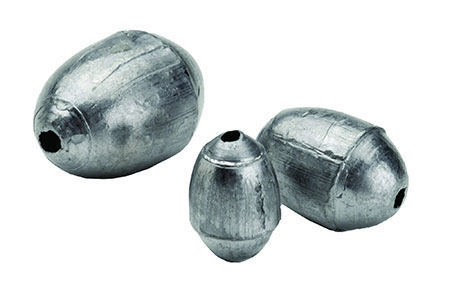
Fish will avoid a bait if they detect anything suspicious. Use an egg sinker to keep the fish from detecting the weight of the sinker when it picks up the bait. An egg sinker is shaped like an egg and has a hole running through it. Pass the line through the sinker and tie on the rig. When the fish picks up the bait, the line passes through the sinker and the fish doesn’t feel the weight. Egg sinkers work best with live or cut bait because you can let the fish eat the bait before setting the hook.
TROLLING SINKERS
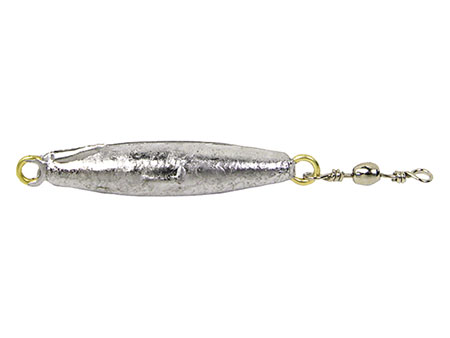
Use a trolling sinker to troll baits at different depths. Trolling sinkers are long and slender and pass through the water easily. The best models have swivels at either end to keep the sinker from twisting the line. How much lead you use depends on how fast you are trolling and the size of your bait. Use a long leader to keep the sinker as far as possible from the bait. To get a bait even deeper, use a planer, which features a metal wing that pulls the line deep in the water. When a fish hits the bait, it trips the wing and the angler can fight the fish. Another way to troll a bait deep is to use a downrigger. A downrigger consists of a short boom and winch attached with cable to a heavy lead ball. The fishing line is clipped to the ball and dropped to the desired depth with the boom and winch. Regardless of how you troll, use high-quality bearing swivels at all connections to avoid line twists.
SPLIT-SHOT SINKERS
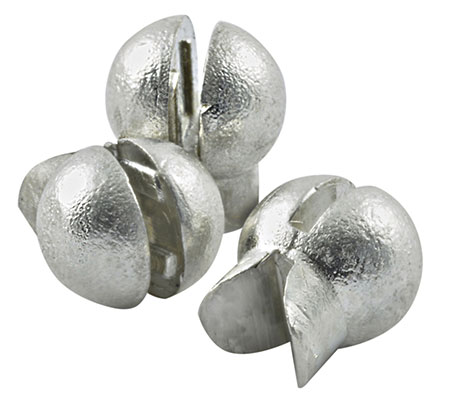
You can pinch one of these small balls of lead on the leader above the hook to carry the bait a few feet under the surface. Split-shot sinkers work best with small baits, light line or low current.
SPECIAL SINKERS
Many types of fishing require special types of sinkers. Salmon anglers in California, for example, use breakaway sinkers that drop from their line when a fish hits the bait. Fishermen who are slow-trolling live baits use big jig heads, while those fishing over rocky terrain may use slender sinkers. Whatever type of saltwater fishing you do, there is a sinker that will keep your bait in the feeding zone.
Saltwater Fishing Rigs
Learn a variety of saltwater fishing rigs. How to set up your saltwater bait, two-hook, three-hook rigs, popping cork and more.
TWO-HOOK BOTTOM FISHING RIG
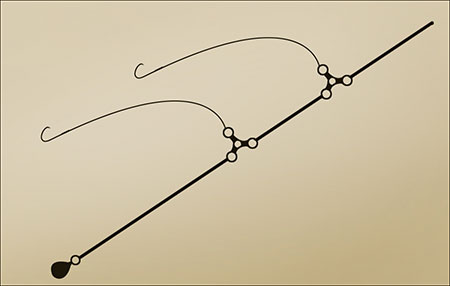
A two-hook bottom rig is probably the most versatile of all saltwater fishing rigs. You can use a two-hook bottom rig to catch everything from pan fish to giant grouper. While premade saltwater fishing rigs are available, it is easy to tie your own. For smaller fish, start with an arm's length of 30- to 50-pound monofilament and tie four 2- to 3-inch dropper loops 3 to 4 inches apart. Attach a sinker to the bottom loop, a hook to each of the two middle loops, and the line running from your fishing reel to the top loop.
For larger fish, use 50- to 100-pound test leader, a snap swivel, two three-way swivels and a regular swivel. Tie a 6- to 8-inch piece of leader between the snap swivel and one of the three ways. From the second eye of the three-way, attach an 8- to 10-inch piece of leader and tie on the second three-way. Attach another 6- to 8-inch piece of leader to the second eye of the second three-way and tie on the swivel. From each of the remaining three-way eyes, tie a short piece of leader snelled to a hook. Make sure the leaders are short enough that the hooks don't become tangled. The hooks can be dressed up with bucktail hair, beads, spinners or floats to attract fish.
THREE-WAY SALTWATER FISHING RIG
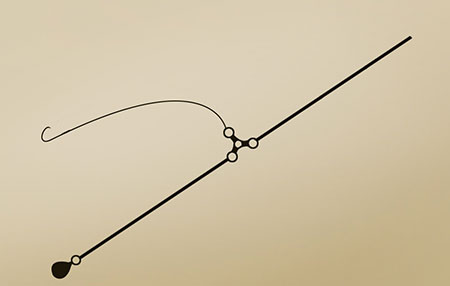
A three-way saltwater fishing rig is similar to a two-hook bottom rig, except that it only has one hook. Start with a three-way swivel, tie a short piece of leader to one of the eyes, then tie a longer piece to the other eye. The shorter piece of leader gets a sinker or jig, and the longer piece of leader gets a hook or another lure. The idea is that when the three-way is dropped, drifted or trolled, the lure or saltwater bait on the longer piece of leader hovers just over the bottom.
CAROLINA RIG OR FISHFINDER RIG
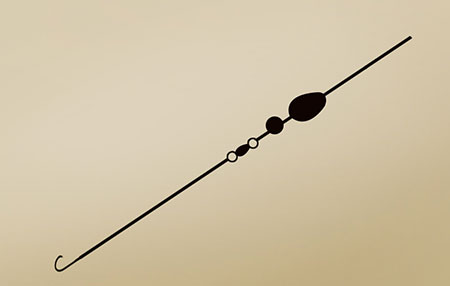
A Carolina rig is one of the best saltwater fishing rigs because it can be used with an artificial or natural saltwater bait and it puts the bait close to the bottom while keeping it from getting hung up on the bottom. To make a Carolina rig, start by threading the main line through the hole in an egg sinker. Tie a swivel to the mainline and attach a 6- to 12-inch piece of leader that is snelled to a hook or artificial saltwater bait like a soft plastic or a jig.
A Carolina rig works with egg sinkers up to 3 or 4 ounces. For a heavier weight, replace the egg sinker with a fishfinder slide and clip on a heavier weight. To keep the sinker or fishfinder from snagging on the terminal tackle, place a small plastic bead on the mainline between the weight and the swivel. The advantage of a Carolina rig or fishfinder rig is that it allows the fish to pick up the bait without detecting the weight of the sinker.
POPPING CORK

A popping cork is a fishing rig that preys on a fish's keen sense of sound and features a short piece of stiff wire threaded through a foam or cork float and a couple of metal or plastic beads. A loop at one end of the wire is tied to the mainline, while the loop at the other end is tied to a piece of leader long enough to dangle a jig or natural saltwater saltwater bait just over the bottom. A quick snap of the rod tip makes the float pop against the beads and causes the bait to hop below. Let the float settle before popping it again. This rig works best where shrimp or baitfish are popping on the surface.
Saltwater Fishing Hooks
Hooks are the unsung heroes of fishing. So much thought goes into rigs, lures, rods and reels that most take their saltwater fishing hooks for granted. But the rest is a waste without good saltwater hooks.

FISHING HOOK SIZES
Fishing hook size is measured at the gap between the point and the shank. When considering what size and shape hook to use, consider the size and shape of the bait and the fish. Fish with small mouths will require small hooks. If you are using small pieces of bait or live bait, even for big fish, you may still want to use a small hook, as a larger hook may be difficult to hide in a small piece of cut bait, or could hinder the action of a live bait.
Saltwater fish hook sizes start at a tiny No. 32 and run up to a huge 19/0. From size 32 to 1, saltwater hook size increases while the number decreases. From size 1/0 to 19/0, the hook size increases along with the number. There is no standard in hook sizes, so one brand’s 3/0 may be larger than that of another brand.
While saltwater fishing hooks come in many sizes and shapes, they are generally made out of two materials: stainless steel or high-carbon steel. The first is corrosion-resistant but brittle, while the second will rust but is more forgiving of bends and twists. Both require care and maintenance to sustain. Sharpen fishing hooks with a file or hook sharpener and always rinse them with fresh water and coat with light oil between uses to help extend use.
J-HOOKS

J-hooks come in different styles for different types of saltwater fishing. Choose a hook that matches the size of the saltwater fishing bait you will use and the size of the fish that you will target. Some styles of J-hook work better with a particular species of fish. For example, summer flounder anglers prefer Kahle hooks because flat fish have a mouth that closes horizontally. Bait fishermen usually choose long-shank saltwater fishing hooks that are easy to remove from a fish’s mouth. Some types of hooks are specially designed to work with a particular type of bait. For example, offshore anglers use O’Shaughnessy hooks to rig ballyhoo baits.
The width of the fishing hook’s wire is also important. Use beefy hooks for big fish; a thinner wire on delicate baits like shrimp or worms. Hooks for artificial saltwaterfishing lures are specially designed to work with a particular type of lure. Still, you may want to change the factory hooks with a different size or style hook to match your type of fishing. Saltwater fishing jigs should have a hook that matches the size of the trailer that you’ll use. When striking a fish with a J-hook, lift the rod tip straight up while reeling in any slack in the line. To avoid deep-hooking a fish (getting the hook down into the fish’s gut or gills rather than just the mouth), set the hook at the slightest tap on the line before the fish has a chance to swallow the bait.
CIRCLE FISHING HOOKS
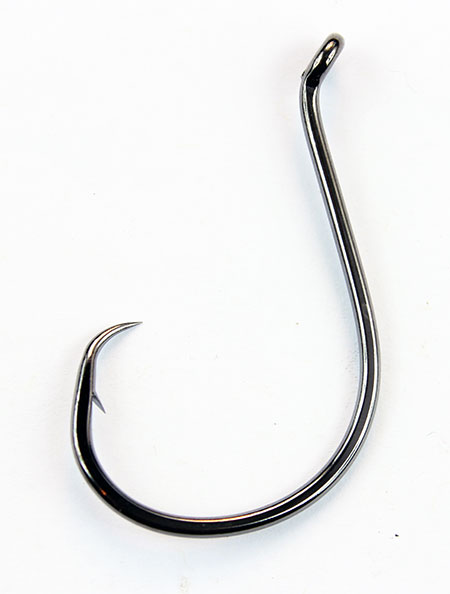
The birth of catch-and-release fishing spawned the invention of circle fishing hooks. These are shaped so that the point turns toward the hook shank, almost making a circle. Circle hooks are mostly used with live or cut saltwater fishing bait because the shape of the hook keeps it from becoming lodged in the fish’s gut.
When a fish swallows a bait on a circle fishing hook and swims away, the line pulls the hook out of the fish’s stomach and into its mouth, where it will catch in the jaw. Circle hooks are almost foolproof. Instead of jerking the rod to set the hook, simply apply steady pressure until the hook finds its way into the fish’s mouth. Studies have shown that circle hooks dramatically reduce the number of fish that die after being released. In some fisheries, the use of circle hooks is even required by law. When fishing with natural baits, circle hooks just make sense.
TREBLE FISHING HOOKS

Treble fishing hooks work by snagging the fish when it hits a bait. Treble fishing hooks are sized the same way as other hooks, but it usually takes a smaller treble hook to catch the same size fish as a circle or J-hook. Most plugs use treble hooks so that when the fish realizes it has eaten a lure instead of a real fish, it is already hooked.
Still, many anglers switch treble hooks for J-hooks on their lures to help protect the fish and their fingers. To change out the hooks, you’ll need a pair of split-ring pliers. Use the finger at the end of the pliers to pry apart the wires on the split-ring, then remove the old hook just like taking a key off a key ring.